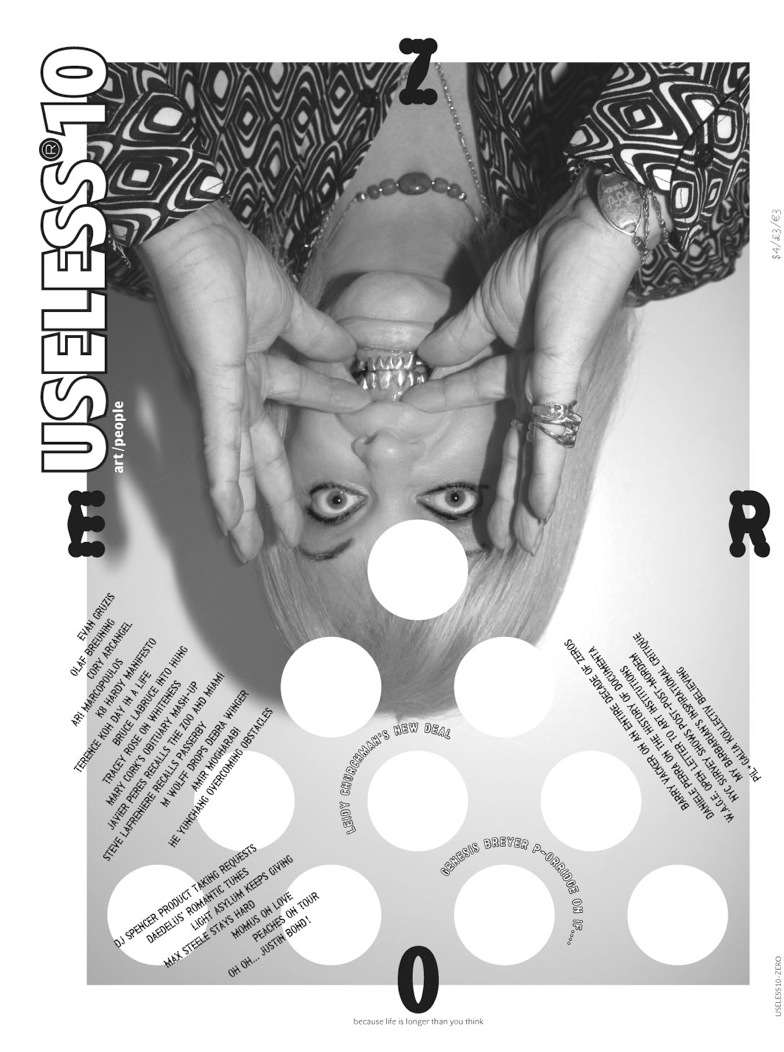Paging: A Useless Ventur

PHOTO BY JACK SIEGEL
This month, Conrad Ventur, writer, artist and publishing magnate, releases Useless 10, the tenth edition of the magazine whose masthead lists him as both founder and editor-in-chief, which will be published for the first time in a digital format to accompany the print edition.
Ventur started the sometimes annual, sometimes bi-annual Useless in 2002, while he was working as a freelance photographer for Spin and Rolling Stone and moonlighting as a DJ at a bar in Brooklyn called LUXX. “I’d do a set, and then squeeze myself through the crowd, taking roll after roll of film,” he remembers. “Especially in the VIP lounge in the basement, which was a closet.”
It was there he’d find Stephen Sprouse, Hedi Slimane, and Alexander McQueen, among others. “And at the time, the truly lame wouldn’t dare go to Brooklyn because they had that kind of ‘we don’t go to Brooklyn’ attitude,'” Ventur says. The confluence of artists at LUXX from all media—art, music, fashion—undoubtedly informed Ventur’s editorial sensibility when he launched the magazine. Many of the people he encountered would later become subjects of features, like Klaus Biesenbach, who was featured in Useless 8, and would bring Susan Sontag along with him.
The magazine was birthed in 2004, fueled by Ventur’s deep sense of ennui towards the stories he was being assigned from mainstream publications. He realized that the things he really wanted to publish might not have a place in the larger, more commercial media world.
Despite its moniker, the magazine has proven itself to be far from “useless,” featuring interviews, commentary, and reviews on subjects that fly below the pop-culture radar, and usually can’t be confined to one discipline. Ventur generally focuses on hybridity: artists who play music, curators who make art. Rather than confining the subjects he features to a single format (interview, review, critical reflection), he generally allows contributors to do whatever they want with their pieces. In Useless 10, most of the articles are reflections on the self written by artists. In many cases, they are illustrated with self-portraits.
“I choose people I believe in,” he continued. “I choose people who want to be in this format. And that actually simplifies a lot of things. I’m not chasing down people to do puff pieces.” Past feature subjects have included Dash Snow, Amy Sedaris, Todd Haynes, Agathe Snow, Isabel Toledo, Iona Blaswick, Christophe De Menil, and Dara Birnbaum, just to drop a tangled set of names. “I think that the reader expectation might be that it’s this hipstery sort of publication, but actually as you get into it, you’ll be surprised by what you find.” In Useless 9, released in 2009, Ventur featured an interview between Andrew W.K., the entertainer, and Bad Brilliance, a musician who appears in public with a gigantic yellow “ball head” emblazoned with his logo sticking out of the collar of his suit. Their dialogue, which occurred entirely in an online chat, ends with an exploration of the politics of culture in America as embodied by the first three comments on an unspecified Lady Gaga video.
While there aren’t explicit themes, there’s a sense, flipping through the issues, of Ventur blossoming as both an artist and a thinker. “A lot of the magazine has changed with me, as I’ve grown up in the last six years,” Ventur explained. “Right at the beginning, it was a ‘scene scene’ with music and a little bit of the art world. Within a year and a half of starting it, I went to graduate school. The content changed after my two and a half years living in London. It graduated from being a New York publication to being an international one.”
The tenth edition of Useless is the most ambitious yet. Featuring two cover stories—one on Genesis Breyer P-Orridge, the other on artist Leidy Churchman—the issue will also include first-person recollections and features by some of the best minds in the culture industry. An interview with artist Olaf Breuning by Ventur himself explores the collapse of the economy in 2008, and how it has affected Breuning’s production. There is a manifesto by K8 Hardy, and a centerfold on Genesis.
Although Ventur mourns the birth of the digital edition with the nostalgia of someone who is loath to get rid of their vinyl, he admits that the online format will allow for a more flexible visual presentation. “Our online version has many more pages and many more images. The format allows us to have six-page spreads rather than four-page ones.” More of Useless is something that no one will mourn.






